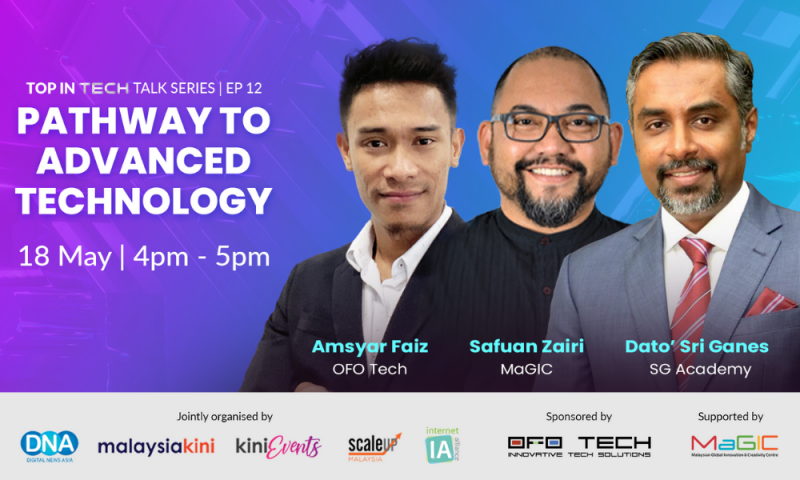How can Malaysia move to become a high-tech economy? This is a pertinent question, one that sits at the core of the country’s strong ambitions to become, as often touted, the Heart of Digital Asean.
The answer is, perhaps expectedly, complex. No digital economy is without various moving parts across public and private entities. But, as the recent Top in Tech Talk titled “Pathway to Advanced Technology” points out, what’s most important is the notion that technology advancements shouldn’t be made “just for the sake of advancing technology”, but to properly address the challenges and issues of the country.
“The pathway to advanced technology, firstly, is the basic understanding of the [country’s] pain points,” says panelist Sri Ganes.
Ganes, who is founder and group CEO of SG Academy, says that it’s easy for us, as a nation, to be excited with technology buzzwords like Industrial Revolution 4.0 (IR4.0); and to leap into technological advancements like artificial intelligence (AI) and machine learning.
“We can embark on these initiatives, but firstly, we need to understand if we’re solving anyone’s problems,” he explains.
This necessity to create real-world solutions solving real-world problems is exactly why 2020 launched National Technology & Innovation Sandbox (NTIS) is so crucial towards building an advanced nation.
The programme, led by the Ministry of Science, Technology and Innovation (MOSTI) with support from the Malaysian Global Innovation & Creativity Center (MaGIC) and the Malaysian Technology Development Corporation (MTDC) (among others), was launched in August 2020 to allow researchers, innovators and startups to test their products in a live environment.
According to panellist Safuan Zairi, who is senior vice president of Technology and Innovation in MaGIC, the NTIS is there to address the nation’s grand challenges. “We’re not pursuing innovation for the sake of innovation. We want to address the nation’s grand challenges, and how we’re doing this is by harnessing innovation and the latest technology.”
Sandbox rules
More importantly, the NTIS is also about helping accelerate the commercialisation of those tech solutions (via its Structured Sandbox programme). NTIS puts a startup’s solution through several stages of evaluation, using a technology readiness level pioneered by NASA.
If these solutions make it past the technology readiness level, MaGIC then works with MTDC to help the startups procure funding. These startups and their solutions are also matched with organisations that require digital and technology solutions.
This level of scrutiny, Safuan says, makes it easier to convince local businesses to adopt local tech solutions. “We are taking away the fear of working with local innovators – to give a chance for them to push their solutions locally, regionally and globally.”
This, according to fellow panellist and OFO Tech business development director Amsyar Faiz, is a crucial aspect to the programme and tech providers like him.
“Good ideas are a dime in a dozen. But to actually monetise the idea, that’s where the challenge actually lies,” he says. What NTIS does is give local innovators like OFO Tech a “green lane access” to validate the technology they are fore-fronting. In a way, NTIS also serves as a filter on whether the technology is viable to the local market.
“For OFO and other participating companies, the NTIS is something that should have started a long time ago,” Amsyar believes.
Solving challenges
Amsyar adds that the NTIS allows them to work with major industry players like FELDA to integrate and optimise their tech in a commercial environment. Through the sandbox, OFO Tech is attempting to introduce smart farming and analytics into FELDA’s conventional farming operations, such as using IoT and AI to increase productivity and yield while reducing intensive labour.
OFO Tech has also been able to use smart cameras and FELDA Bentong’s garbage trucks to better collect data on road conditions, which is eventually used to better predict road damages and cut down on repair time.
“The tech is out there – it’s just a matter of synchronising the resources, brainpower and technology, and not relying on international expertise while focusing on domestic abilities,” Amsyar adds.
For Ganes, there is also a need to develop talent to solve immediate industry problems. While he agrees that there’s a need to develop talent requirements for the near future, he adds that “we can complement building talents which are relevant to the current moment”.
For this, there needs to be a clear academic pathway in developing both talent for the near future, and talent we need today. Furthermore, Ganes calls for a focus towards developing skilled workers into system integrators and managerial roles. These are workers with the proper skills that could be developed and put into the system faster than university graduates. For this, micro-credentials can prove vital.In the end, the pathway to advanced technology, at its core, is about solving the problems of today, and developing solutions for the near future.
Watch the replay here:





